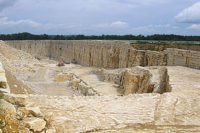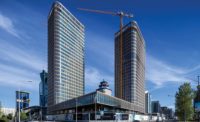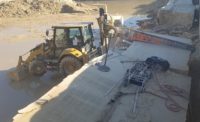With 15 to 20% of its market comprising the U.S., VM Kaldorf (VMK) has a strong global presence and continually strategizes to further grow its business. Recently, Stone World had the opportunity to ask Johannes Semmler, managing director, and Hubert Kuenzl, export manager, about recent investments and their approach to working with and promoting the company’s Jura limestone to architects. Here’s what they had to say.
Has VMK made any new investments in the past year? If so, what were they and how will they benefit your company?
Semmler: VMK, as part of the Franken-Schotter Group, is on a constant investment path. That includes every single area of our company. In the office, we invested in a new IT infrastructure and software in order to streamline business processes. On the operations side, we invested in a new splitting machine and a head polisher to increase efficiency for flat panel production.
Also, we have commissioned a new wheel loader and a drilling unit in 2019 for our own quarries. These modern machines are more efficient and allow us to achieve the output needed with less resources.
We also undertook a huge effort to achieve a comprehensive certification of Environmental and Ecological Excellence. The Eco-Management and Audit Scheme (EMAS) certificate we achieved is a management scheme that goes far beyond the already very strict German and European legal requirements for eco-friendliness. This means a commitment to have external audits every year, combined with the obligation to become better every year by setting and achieving new goals, in a kind of spiral development way.
We are very proud of that achievement because it benefits the environment and gives us a unique selling position. For VMK clients, it means that they can be sure to get officially certified Jura limestone by one of the most technically advanced and ecologically friendly companies.
Has the company’s stone exports to the U.S. increased in the last year or two? If yes, what are some reasons you believe this is?
Kuenzl: Despite the competition with other stones and artificial products, we continue to have a strong footprint in the North American market. We have seen an increase of sales in our fine VMK Jura Grey limestone. It seems the market has picked up on the trend of gray color that we see in other markets in the world.
What are you finding to be your most popular stone in the U.S. market?
Kuenzl: The U.S. market mainly asks for VMK Jura Beige in a light color tone in a fine honed surface.
How about sizes and finishes? What are you seeing requested the most in the U.S.?
Kuenzl: We can provide any size and finish that the market requires. The U.S. often asks for honed finishes in 12 x 12 or 12 x 24 inches. For facade panels, the requested dimensions are often 2 x 4 feet.
Approximately how much stone do you export to the U.S. annually?
Kuenzl: Approximately 15 to 20 percent of our export business is to the North American market.
What are some recent projects you have worked on? Did you have members of the design team visit the quarries? If so, what are points that were discussed with each project?
Semmler: We had the design architect of the New York City 430 E 58th Street high-rise project visit our factories and quarries. We presented a mock-up of the selected stone, Jura Beige with a sandblasted surface, decorative grooves and undercut anchor cuts for facade installation.
We see the selection process as a cooperative effort of the owners, designers and installers. We develop ideas, discuss options, logistics and lead-times. We were successful with this project.
2019 was a good year for excellent wine. We had the honor to outfit OPUS ONE Winery out of California with our fine VMK Jura Beige brushed limestone. Additionally, VMK was happy to provide more than 10,000 square feet of Jura vein cut facade panels for a world-famous French Wine Chateau.
Do you promote your stone to architects as to have them specify your material for projects? If so, what are some ways you do this?
Kuenzl: We do promotions to architects in the Franken-Schotter-VM Group. Direct contact, visits and phone calls are paramount for success. Also, trade shows, like Coverings, TISE and Marmomac, also provide a valuable platform for contacts with architects. Additionally, we have started to attend AIA forums or host symposiums with architect schools here in Germany.
Do you find you need to educate architects on the benefits of using Jura limestone?
Semmler: Of course, this is always necessary. Architects have a high operational tempo and we learn that they have a high turnover rate of their young professionals. If you don’t continue to educate, come to see and talk to them, stone as a building material will lose attention. But we think this is a mutual process. Architects also educate us about new trends, developments and design approaches. That helps us to develop the products needed and the architects to understand what a wonderful material our stone is to work with. That is why we also adapted to Building Information Modelling (BIM). We are BIM ready in the group.
What are some goals VM Kaldorf has for 2020?
Semmler: We will continue to strive for best service and great VMK Jura limestone products for our clients. We will continue to increase our presence in the North American market along the whole value chain.
|
What is EMAS? EMAS is the European Union (EU) Eco-Management and Audit Scheme which allows all types of organizations to improve their environmental performance and achieve recognition for doing so. Its origins lie in European Council Regulation 1836/93, which allowed participation by industrial sector organizations within the EU in the Scheme. This regulation is now in its third version and extends to all types of organizations. Source: www.nqa.com/en-gb/certification/standards/emas |








